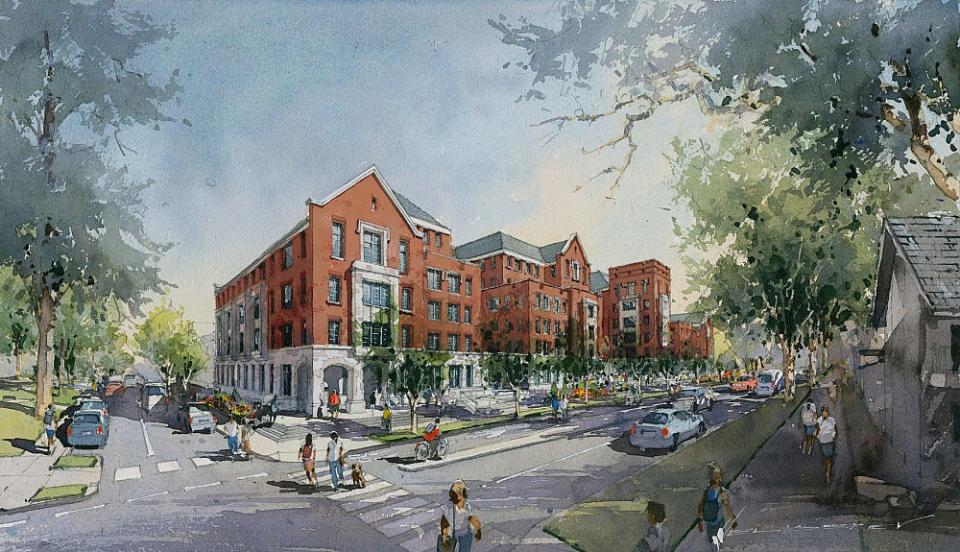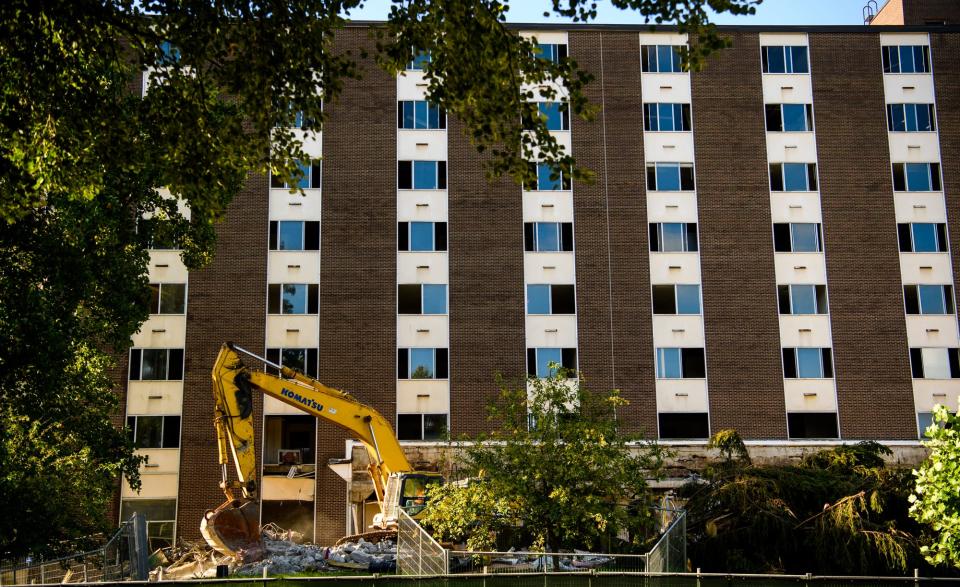Here's what Indiana University plans to build on the former Poplars site
The $81 million apartment building Indiana University plans to construct on the site of the former Poplars Building will be six stories and 192,000-square-feet.
The new structure, to be completed in March 2026, will provide 158 furnished apartments and 396 beds, ranging from studios to four-bedroom units. IU said the apartments will cost from $1,315 to $1,834 per month.
Building to feature limestone, red brick, courtyards
The university said the building will have four-story elements fronting Seventh Street, and three landscaped courtyards that will open onto Seventh Street “to create a friendly and varied pedestrian experience.”

The building’s exterior will feature limestone veneer, red brick that is “cohesive with other campus and local buildings,” bay windows, slate roof tiles and stone accents.
Each floor will have residential units. The ground floor also will have a lobby off the main entrance courtyard, office areas, lounges and space for studying.
The apartments will have one bathroom for each bedroom.
The Poplars project will be designed, constructed and financed by BPIU Partners. The facility will be operated and maintained by Buckingham Management, an affiliate of BPIU Partners. The building’s architectural design came from Washington, D.C-based Torti Gallas + Partners.
Who will live in IU's new apartment building?
While the building will be geared toward graduate students, critics maintain the prices for the units, with some exceeding $1,800 per month, will be much too high for most students.
University officials have said the new building on Seventh Street is one of many approaches they’re taking to help solve the Bloomington housing crisis.
The Poplars Building, which the university tore down in summer 2022, was constructed in 1964 as a luxury dorm for female students. Three years later was converted into a hotel that hosted celebrities including Elvis Presley. It subsequently served as an office complex for university employees.
At the time of the building's destruction, the university said it planned to retain the area as greenspace. IU since then has said the new structure was being built in part to make up for other on-campus facilities that have been torn down, including Evermann, Banta, Bicknell, Hepburn and Nutt apartments. After graduate students, the new facility will be assigned to faculty, staff, employees, undergrads and visiting scholars.
Critics: Not affordable for graduate students, staff
Predicted rental prices have generated some backlash among members of a university working group on student housing.

The group’s co-chairs — Chelsea Brinda, a doctoral student, and Deborah Cohn, professor of Spanish and Portuguese — said it would be difficult for graduate students and university staff to afford the new units.
At $1,315 per month, the annual cost to live in the least expensive unit would be $15,780. That kind of rent payment would require an annual income of $52,600 to not be considered "rent burdened." The federal government considers households rent-burdened if they have to spend more than 30% of their income on housing.
The income of $52,600 is more than twice as much as the minimum stipend for graduate students. At $1,834 per month, the annual rent costs would be $22,008, requiring an annual income of $73,360 to avoid being considered rent-burdened.
Brinda pressed members of the Bloomington Faculty Council in late summer about what the university was doing to help address the local housing crisis now, as graduate students already were struggling to find housing for the current semester.
“What steps will the campus take to make a serious commitment to understanding the plight of finding affordable, accessible housing for graduate students that students are facing today and act on it so that we can feel relief sooner rather than three years from now?” she asked.
IU dean: Affordable housing 'difficult problem'

Rahul Shrivastav, the university’s provost and executive vice president, said the new apartment building was one of many ways the university is trying to provide more housing.
IU also has prioritized housing owned by the university for graduate students and was working with the city to increase the local housing stock, he said.
However, Shrivastav cautioned the problem would not be solved in the short term.
“I wish there was a rapid solution, but this is a problem … that is probably a result of many decades of decision making in the area,” he said.
David Daleke, dean of the IU Bloomington Graduate School, agreed, saying the problem could be solved only if IU and the community collaborate.
While Bloomington is seeing a significant number of apartment buildings going up, it will take some time for that additional supply to affect availability and affordability of existing units, he said.
“It is a difficult problem,” Daleke said. “We’re doing what we can.”
Brinda has criticized the university for failing to incorporate in its strategic plan any of the recommendations issued by the working group, which had identified four objectives and 19 strategies to achieve them, including replacing graduate student units with more appropriate units to create more space for students to live on campus.
Daleke said the university was working on one of the group's recommendations, which was to provide more information on housing. He said IU was revising its graduate school website and adding a page specifically on housing.
Boris Ladwig can be reached at bladwig@heraldt.com.
This article originally appeared on The Herald-Times: IU Bloomington's new building to feature 158 furnished apartments

